°Arcus°
Home » Creation stories » Europe and Northern Asia
CREATION STORIES FROM EUROPE AND NORTHERN ASIA
BURYAT
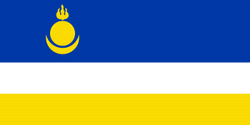
In the beginning, Sombov existed surrounded by the waters of chaos. After some time, he saw Anghir, a water bird, which he ordered into the depths to retrieve the earth.
Anghir returned, bearing black earth and red clay.
Sombov proceeded to fashion the world from the earth, before making a man and a woman, covered in wool, from the clay. He deferred, however, from bringing them to life, until he had obtained souls for them. To this end, he headed off to heaven.
Sombov had left a dog behind to guard his work. Now, at this stage, dogs still lacked fur. Thus, the poor beast was shivering with the cold, yet remained loyal to his master Sombov, maintaining his station.
However, some time later, Shiktur, a demonic figure, appeared and tempted the hound with the promise of a fur coat in return for access to the clay figurines. Eventually, the dog yielded, whereupon Shiktur spat upon the human figures.
Upon his return, Sombov was incensed at this turn of events, and condemned the dog to a life of shivering in spite of its fur. He then carefully peeled off the wool from the human figures, in order to remove the stain of Shiktur's expectoration. This, however, left them - the woman in particular - hairless on certain parts of their bodies after he had bestowed life and soul upon them.
CELTIC
The worldview of the Celts is somewhat enigmatic, surviving primarily in late, heavily Christianised, Irish and Welsh sources, as well as earlier notices from Greek and Roman authors.
One probable feature of Celtic belief was the early and catastrophic separation of the heavens and the earth (in common with Greek notions of the separation of Uranus and Gaia), which may lie behind the enigmatic statement of the Celts of the Illyrian coast's statement to Alexander the Great that the only thing they feared was the falling of the sky, an eschatologisation of this primordial event.
Other than this, the Celtic worldview can perhaps be seen as incorporating a world tree, upon which were three worlds: -
- the Sky, the domain of the gods of the sky, associated with fire (as fire travels upwards);
- the Land, the domain of man, associated with trees and sacred stones (which span the distance between Sky and Land); and
- the Sea, the domain of the ancestors, as well as the Sidhe, accessible through water.
This tripartite worldview is perhaps attested in the notices of the three Gaulish gods Taranis, Esus and Teutates: -
- Taranis, to whom sacrifices were made through burning;
- Esus, whose victims were hanged from trees before being dismembered; and
- Teutates, to whom sacrifices were upended and drowned in a vat of liquid.
The Celts also seem to have had two seasons, represented in folklore by the Oak King and the Holly King, whose terms of office changed at Beltane (May Eve) and Samhain (Hallowe'en). The Welsh mythological material attests to the competition between Gwythyr ap Greidawl and Gwyn ap Nudd (the ruler of Annwn, the Welsh Otherworld of the Tylwyth Teg) over Creiddylad, as well as Gwenhwyfar's abduction by Melwas of the Gwlad yr Haf ("Summerland"), and her subsequent rescue and restoration to her husband Arthur. The Mabinogion's account of Pwyll and Arawn changing places for a period may also be a reflection of this particular concept.
Other concepts which the Celts may have held in common with other groups include a primordial subterranean spring, from which all world rivers had their source. This well is surrounded by hazel trees, and filled with salmon which, eating the hazelnuts, gain all worldly wisdom. Such a fountain - variously known as Sid Nechtain (cf. the name of the deity Nodens or Nodons) or associated with the personages Segais or Condla - appears in Irish material appertaining to the great Irish rivers the Shannon and Boyne. The Metrical Dindshenchas mentions: -
- A spring (not sluggish under the pleasant sea in the domain of Condla [...] with flow unfailing [...] by the edge of a chilly river [...] whence spring seven main streams.
Here thou findest the magic lore of Segais with excellence, under the fresh spring:
over the well of the mighty waters stands the poets' music-haunted hazel
The spray of the Segais is sprinkled on the well of the strong gentle lady, when the nuts of fair Crinmond fall [Sinann 1.4-7]; - Connla's well, loud was its sound, was beneath the blue-skirted ocean: six streams, unequal in fame, rise from it, the seventh was Sinann.
The nine hazels of Crimall the sage drop their fruits yonder under the well: they stand by the power of magic spells under a darksome mist of wizardry.
Together grow, in unwonted fashion, their leaves and their flowers: - a wonder is this, though a noble quality, and a wonder their ripening all in a moment.
When the cluster of nuts is ripe they fall down into the well: they scatter below on the bottom, and the salmon eat them. [Sinann 2.3-6]; - Sid Nechtain [...] from which flows the stainless river whose name is Boand ever-full.
Fifteen names, [...] given to this stream we enumerate, from Sid Nechtain away till it reaches the paradise of Adam.
Segais was her name in the Sid to be sung by thee in every land: River of Segais is her name from that point to the pool of Mochua the cleric. [Boann 1.1-3].
Additionally, the otherworld - inhabited by the gods - was conceived as being variously across (or, indeed, beneath) the sea or on the far shore of a river system. With regards to the latter conception, Branwen ferch Llŷr, the second of the Pedair Cainc y Mabinogi, places "Ireland" - which in this instance appears to be a cypher for a western otherworld - "not far across the sea, [over] shallow water. It was but by two rivers; the Lli and the Archan were they called; and the nations covered the sea."
CHUKCHI (LUORAWETLAT)
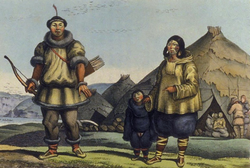
In the beginning, Raven created himself. He then brought other things into existence.
He used to live with his wife in an enclosed space, but became increasingly bored by his surroundings. His wife suggested he create the world, but he said he could not. Thereafter, his wife said that she would create something and fell asleep, with Raven watching her. He watched as she lost her feathers and grew into a huge, swollen mass, from which twin children emerged. These, like Mrs. Raven in her post-creative state, were featherless.
The children awoke and wondered what Raven was. They woke their mother, who told them that it was their father. They proceeded to mock this strange creature, with his feathers and croaky voice, which prompted a telling off from their mother.
This compelled Raven to seek to create something himself, to which end he visited the Benevolent Ones, including Dawn, Dusk and Evening for advice. He received none.
Next, he went to where some odd beings were seated. They explained that they were to be the seeds of the human race, but that they needed an earth to populate. Raven took one of them and they flew off. Raven defecated, with his guano forming the mountains, valleys and waters of the earth. His man-seed companion asked what the people would eat, whereupon he produced animal and plant life.
As the men-seeds became human, they inhabited this new realm, though there was no woman to share in their toils. One day, a little spider woman appeared and created women. Raven then proceeded to enjoy conjugal relations with them, which led the men to follow his example.
Other stories have Raven and Creator as the first two living beings. Raven told Creator to make a man, but the man he created was a hairy, four-legged beast with huge claws and teeth. He had no use for cooking, but ate all of the animals he caught raw. Creator became alarmed at this and thought that this beast would be the end of the universe.
Raven, however, merely suggested a few adjustments here and there, which were put in place. The beast was made to walk upright, had shorter arms and had clothes in lieu of hair. Creator then made reindeer from plants for this new human to herd and use for food, as well as dogs from wood to help in these endeavours.
FINNISH
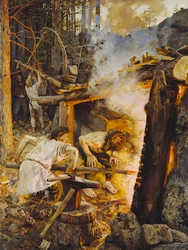
The Finnish cosmogony was preserved in folktales which were collected by Elias Lönnrot in the 19th century in his meisterwerk the Kalevala.
In the beginning, there were Sky and a primordial ocean. Sky had a daughter, Ilmatar, who eventually made her way down to the waters to rest. Subsequently, she swam and floated on the sea for some 700 years, lonely and longing for companionship. One day, she notices a teal flying overhead, seeking a place to rest and nest. Ilmatar, who had her knee raised, raised it further until the bird, thinking it land, lighted upon it, and laid seven eggs, six of gold and one of iron.
The action of the teal, in sitting on the nest to warm the eggs, caused Ilmatar's knee to burn, whereupon she jerked it downward into the water, causing the eggs to shatter by wave and wind. From the bottom half of one of the eggshells, land grew, while the top half brought the present-day sky into being.
Several centuries passed before Ilmatar, filled with life force, grew fecund, creating the topography of the land. Additionally, impregnated by the sea, she brought forth a son, Vainamoinen, who proceeded to swim for several years, finding a barren island upon which he landed. Vainamoinen implored the Great Bear for aid, and was subsequently sent a boy carrying seeds, which, when scattered, gave rise to plants, including an oak which grew so large it obscured the light of the sun. Vainamoinen now asked his mother for assistance and Ilmatar sent a small fellow with an axe. The man grew to gigantic proportions and used his axe to chop down the oak, restoring light to the world.
GREEK
GREEK MYTHOLOGY
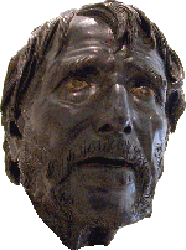
HESIOD'S THEOGONY
The best-known Greek mythological narrative dealing with the creation of the universe is undoubtedly that contained within the Boeotian poet Hesiod's Theogony. This source describes the generation of various gods and goddesses, along with specific groups of deities, from a starting point in Chaos. Chaos - perhaps best understood as a watery chasm (somewhat akin to the Egyptian Nu) - is the first principle, within which are generated successively Gaia, the personification of the earth, and Tartarus, the deep realm beneath everything where dwell imprisoned the most heinous of sinners in Greek lore.
The next beings generated are Erebus ("darkness," associated with the realm of the dead in the Odyssey) and Nyx ("night"), with the latter producing Aether (the upper air) and Hemera ("day"). Meanwhile, Gaia's first offspring is "starry Heaven, equal to herself," Uranus, who would become her spouse.
This couple become parents of the twelve elder Titans: -
Oceanus | Theia |
Coeus | Rhea |
Crius | Themis |
Hyperion | Mnemosyne |
Iapetus | Phoebe |
Cronus | Tethys |
The couple go on to produce two other groups of offspring: -
- The Cyclopes (Brontes, Steropes and Arges); and
- The Hecatoncheires (Cottus, Briareus and Gyes).
Eventually, Gaia becomes distressed at Uranus' sexual demands, and wishes to be separated from him. This is accomplished by the youngest of the Titans, Cronus, who emasculates his father with an adamantine sickle. However, the prophecy states that, as Cronus has done to Uranus, so will his own son do to him. In order to stave off the possibility of being usurped, Cronus duly eats the oldest five of his six children by Rhea - Hestia, Demeter, Hera, Hades and Poseidon - though his attempt to swallow the sixth is stymied by the then-queen of the gods, who gives her husband a stone to eat instead, before spiriting this youngest son - Zeus - off to Crete. Eventually, Zeus duly releases his bretheren and sistren, before engaging the forces of the Titans in a war for supremacy, the Titanomachy. He is aided in this endeavour by his allies, the Cyclopes - who give him his famous weapon, the thunderbolt - and Hecatoncheires, who are eventually posted as guards before the gates of Tartarus, where the Titans are eventually imprisoned.

THE COSMOGONY OF ALCMAN - THETIS AS CREATRIX?
The Theogony also describes the lifes and loves of a plethora of sea deities, among whom is Nereus, a son of the primordial Pontus. Nereus had a host of daughters, the most prominent among whom was Thetis, who features in later myths as the mother of the great hero Achilles.
However, Thetis may also have been so much more to other Greeks: in the so-called "Alcman cosmogony," written by the 7th century poet of that name, she would appear to be the prime mover behind creation. This enigmatic cosmogony has a number of interpretative problems: -
- first of all, it appears in a scholiast, which considerably postdates Alcman: as such, it is unclear as to whether Alcman intended the passage cited as a creation account or whether the scholion is reading such an interpretation into the text;
- secondly, the name Thetis is a reconstruction in the text, which only yields the final three letters.
The account is reconstructed as follows: -
Alcman - like Hesiod, indeed, before him - may well be signalling the later development of philosophical concepts in his creation account.
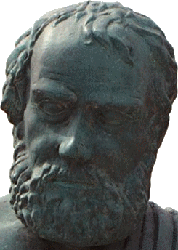
THE COSMOGONY OF PHERECYDES
Another early writer who speculated on the creation of the world was the mysterious Pherecydes of Syros, a "proto-philosopher," whose cosmology is reconstructed by Hermann S. Schibli in the following stages: -
- Chronos, Zas and Chthonie were three entities who had existed from the very beginning of time;
- Chronos cast about his seed, creating fire, air and water, which were deposited into five hollows;
- this admixture brought about another generation of gods: -
- fiery gods dwelt in the heavens (Uranus and Aither);
- the gods of wind dwelt in Tartarus;
- the water gods' domain was Chaos; and
- the gods of darkness dwelt in Nyx.
- This being accomplished, Zas, now known as Eros, married Chthonie: he was served by the new generation of gods;
- on the third day after the hieros gamos, Zas created a great robe, onto which he embroidered Earth, Ogenos and the mansions of Ogenos;
- once completed, the robe was presented to Chthonie;
- the gods celebrated and the earth, like a winged oak, took root in the depths of Tartarus, whilst its trunk was encircled by Ogenos and its branches reached up to Uranus;
- within Tartarus, Ophioneus was born: along with his monstrous offspring, he challenged Cronus for the supremacy;
- it was decreed that whichever party fell into Ogenos would accept defeat, whilst to the victors, Uranus;
- Cronus, with the support of Zas-Eros, defeated Ophioneus in single combat, leading to the Ophionidai being thrown into Ogenos, to dwell within the mansions of Ogenos;
- Cronus was crowned king of Uranus.
The cosmology is as follows (from top to bottom): -
- Uranus;
- fiery Aither;
- the earth; and
- Tartarus (guarded by the Harpies and Thuella, daughters of Boreas), Chaos and Nyx.
Additionally, according to Pherecydes, a river of birth flows out of Tartarus, carrying the souls of those who have committed heinous acts back down into Tartarus.

ORPHIC COSMOGONIES
Possibly the earliest of the ancient Greek mystery cults, that which centred upon the Thracian musician Orpheus - regarded as the ancestor of the likes of Homer and Hesiod - featured a good deal of speculation on the creation of the cosmos. These cosmogonies can be divided into four particular groups, which are reconstructed as follows: -
PROTOGONUS THEOGONY
Nyx lays an egg, from which Protogonus is born. He bears Uranus and Gaia, who in turn produce Cronus the father of Zeus. The primordial egg is swallowed by Cronus who ends up recreating the cosmos as a corollary.
EUDEMIAN THEOGONY
Nyx lays an egg, from which Phanes or Protogonus appears.
The Eudemian theogony also mentions Dionysus (as Zagreus), who is devoured by the Titans. As a result, the enraged Zeus devastates them with lightning, in the aftermath of which humanity emerges from the comingled charred remains of Dionysus and the Titans. Dionysus' heart survives the ordeal, enabling him to be resurrected.
RHAPSODIC THEOGONY
Chronus (not to be confused with Cronus) is the origin of everything. He gives birth to Aither and Chaos, before laying the egg from which Phanes or Protogonus emerges.
The Rhapsodic Theogony also includes the episode of Dionysus and the Titans.
HIERONYMIAN THEOGONY
The egg arises from "the matter out of which the earth was coagulated" and water. From it emerges Chronus, who bears Aither, Chaos and Erebus, before Chronus lays a new egg, from which hatches Protogonus.
In addition to these, a fragment associated with Euripides names water as first principle in an Orphic milieu: -
GREEK PHILOSOPHY
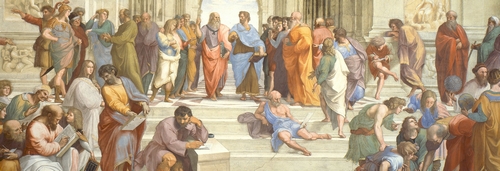
THE MILESIANS
THALES
Greek philosophy developed as a result of rationalising inquiry into myth. The event horizon separating the two is the development of Thales of Miletus' theory that water, rather than some form of divine entity, was the first cause from which creation came into being.
Thales was born in the late 7th century BC, and has the added dignity of being numbered among the "Seven Sages of Greece", alongside contemporaries such as Solon. Later authors in antiquity speculated that Thales was of Phoenician extraction - and he may well have had some non-Greek roots: the name of his father, Examyes, is Carian.
With regards to his proposal of water as first cause, this too may well have had its roots in mythology: many Near Eastern (and other) cosmogonies feature a watery chaos from which the work of creation has its origin.
ANAXIMANDER
Thales was followed by Anaximander, a former pupil, who developed his own theories about cosmology, in addition to work on other subjects which yielded the earliest attempt to map the world.
For Anaximander, the first cause was a principle he termed apeiron ("boundless"), which may well be understood as a congealed mass with characteristics of all of the other elements (such as was supposedly located near the edges of the world).
Anaximander is also notable for having proposed that animal life had its origins in the sea. Whilst Anaximander's version appears rather fanciful and sensational, the marine origins of life on earth are nowadays considered as fact.
ANAXIMENES
The third of the great Milesian thinkers of the late archaic period is Anaximenes proposed that air was the arche, based upon his own observations on the development of clouds and ensuing rain. The air had gradually condensed or been rarified to create the other elements. Anaximenes was also the first to define the elements by the qualities of heat and moisture (hot, dry, cold, wet).
In terms of the origin of the earth, Anaximenes supposed that it was created by air condensing into a flat disk which floated on air beneath, which proceeded to exhale air which, upon becoming rarefied and catching flame, yielded the other celestial bodies.
HERACLITUS
Heraclitus of Ephesus was a philosopher who lived during the 6th and 5th centuries BC. He proposed fire as the ultimate origin - and destination - of everything in the universe.
Key aspects of his philosophy are: -
- that everything in the universe "flows" in accordance with a structure of logic which Heraclitus termed Logos;
- via the "upward-downward path," all matter comes from fire: fire becomes the water of the sea, which in turn becomes earth and air in equal portions;
- every object is a momentary entity with an illusion of some measure of permanence: the process by which an object is built up and destroyed is termed eris ("strife"), whilst dike ("justice") is the harmony within eris which lends objects their appearance of continued existence.
EMPEDOCLES
Empedocles was a Greek from Acragas in Sicily, who is noted as the first to propose the four Western classical elements (which he gave names derived from mythology).
In common with Parmenides and the Eleatics, Empedocles reasoned that creation ex nihilo was impossible: everything was the product of the mixing of pre-existing matter. Whilst the universe was in its "primordial" condition, the combination of the four elements resulted in bizarre forms of life appearing, with those facets which proved functional being the only parts of these creatures which were retained by later life forms.
The cosmic cycle is based upon the conflict between eros ("love") and eris ("strife"). The presence of life indicates that both of the two cosmic forces are present. Chaos is defined as the pure domain of eris, while Harmonia is the pure domain of eros. The cycle can be expressed as taking place in four distinct stages: -
- domination of eris: the four elements are dissociated and no mixing occurs;
- increasing influence of eros: elements become mixed;
- domination of eros: the four elements are perfectly mixed;
- increasing influence of eris: elements become dissociated.
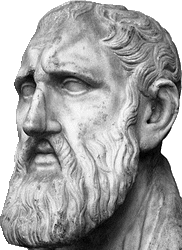
THE STOICS
The Stoics believed that the ordered cosmos appears from fire, which changes progressively into the other four states of matter: -
- air; then
- water; then
- earth;
- air is then evaporated from water as a biproduct of the precipitation of earth;
- this becomes rarefied and, as a result, "aether is spread around in a circle."
KHANTY-MANSI (OB UGRIC)
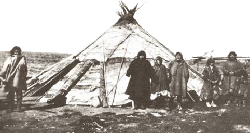
In the beginning, there was the skygod Num-Toorum and the goddess of fertility, Kaltes-Ekwa/Kaltes Ankw. This pair lived in a cottage in the midst of the primordial ocean for many, many years until one day they heard a strange rumbling sound in the upper sky above them. Num-Toorum looked out of the window and saw a loon descend from the sky. The bird landed on the water and dived thrice in search of land, finally surfacing with a globule of mud, which it took with it back up to the sky. The following day, the same course of events occurred, only this time the loon proceeded to smear the mud on the house wherein the old couple dwelt before flying off into the sky again. Some three days later, this mud had grown to such an extent that it covered the entire world.
The pantheon of the Ob-Ugric peoples also mentions the siblings of Kaltes-Ekwa and Num-Torum - who now lives in the highest heaven, thus making it hard to communicate with him directly - who are Hotel-Ekwa (the sun), Etposzojka (the moon), Naj-Ekwa (fire) and Kuly-Otir (the underworld). Eventually, the primordial couple fell out and a brief war in heaven ensued, the result of which was the defeat and expulsion of Kaltes-Ekwa, who is associated with the hare.
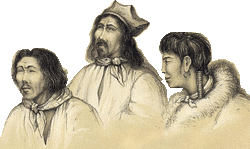
By this stage, the pair had produced numerous offspring, the most notable of whom is undoubtedly the heroic Mir-Susne-Hum (also known as Mir-Setivi-Ho, Kan-iki or Otr-iki), a culture hero revered among both the Ugric and Samoyedic peoples. He was the seventh son who acted as an intermediary between humanity and the creator. He was born on earth after Kaltes-Ekwa's fall from heaven. Mir-Susne-Hum had for a steed an eight-winged iron horse. During his career, he was opposed by the bear spirit Jelping-Ja-Okya. The youngest of the children was the decidedly nervous Postajankt-iki, also known as Sorni-iki or Õi-shlapt-lah-hliotõ-iki (a form of address used during offerings). Such was this figure's condition that the mere mention of his name would be enough to give him a start, which usually results in something bad happening to the person who calls upon him without good cause.
MAGYAR (HUNGARIAN)
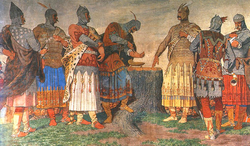
The Magyars, better known as Hungarians, are a people of Europe who arrived in the Carpathian Basin from the Eurasian Steppes during the late 9th century AD.
Before the foundations of the earth were laid, there were only the eternal heights and primordial sea. The ancient sky god sat upon his golden throne in the heavens, with the Great Mother in close attendance.
Within the Great Mother were all the materials needed to create the universe as we know it. Both of these primal deities wore cloaks upon which were etched the stars and planets.
The couple had a son, Magyar, the god of the sun. He asked his father to create humans. In answer to this entreaty, the creator set in motion the fashioning of a world upon which the humans could live.
However, in order to achieve this, the sleeping eye and Magya seeds needed to be retrieved from the bed of the ocean.
To this end, Magyar transformed himself into a golden duck and flew down from the eternal heights of his father's domain and dove into the sea. He made a number of attempts before finally meeting with success. Once awakened, these seeds became animals and the first Magyars. The Magyar nation was traditionally grouped into seven tribes: Jenő, Kér, Keszi, Kürt-Gyarmat, Megyer, Nyék and Tarján.
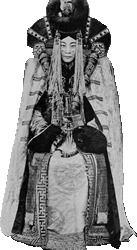
MONGOLIC
Originally co-religionists with the early Turkic peoples, worshipping Tengri as the father of creation, the Mongols came under heavy influence from Tibetan Buddhism, which has informed their stories of creation.
The creator figure was Udan, who began the act of creation within the primordial darkness through the separation of Earth and Sky, establishing three worlds: -
- Heaven for the gods;
- Earth for the living; and
- the Underworld for the dead.
Humanity is the product of the union between the Sky Father and Earth Mother, in common with the Turkic belief.
Another account posits a primordial ocean, alongside the Sky Father. He had two sons, Ulgen Tenger (cf Tengri Ülgen) and Erleg Khan, who were placed in command of the upper and lower worlds respectively. Ulgen dispatched a loon to bring up land from beneath the waters. When the loon failed, he sent a duck, which was successful. Ulgen promptly fell asleep on the newly-formed landmass, whereupon Erleg attempted to pull the land out from beneath him. This effort, sadly for him, was counterproductive, causing the land to expand in all directions. Thereafter, Ulgen awoke and began to populate the earth with his creations.
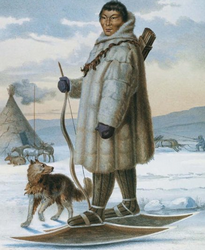
NENETS
The Samoyedic-speaking peoples (a Russian name, unfortunately denoting "cannibals") are a group of peoples of northern Russia. The people from whom the name of this linguistic grouping is taken are now known as the Nenets ("people" in the Nenets language): they are related to the Enets, Nganasans and Selkups. Their creation myth, in common with many other Siberian cosmogonies, features a dog in an important role: -
- the earliest creations were man and dog;
- both were created hairless and naked;
- the devil appeared and began patting the dog, causing it to grow a coat of fur.
Another Nenets myth posits creation as the work of two demiurge figures: -
- Num ("heaven"), the god of the sky and supreme deity of the Nenets; and
- Nga, the god of death.
In one account, Num and Nga collaborate in the foundation of the world order, each competing with the other in order to bring about the lion's share of the creative work.
One story presents an imminent threat to the world order, in which the earth threatened to collapse in on itself. In order to stave off this impending fate, a Nenets shaman sought the aid of Num, who told the shaman to travel beneath the earth, the domain of Nga, and to implore this deity for aid. The shaman secured Nga's support by marrying his daughter, at which point he began to support the earth with his hand, becoming "The Old Man of the Earth."
Also noteworthy is the appearance of a prior race in the lands where the Nenets would later dwell. This group, known as the Sirtia or Sihirtia, were said to have been fine blacksmiths, and to have worn fine apparel, bedecked with metal pendants. They had pale eyes and spoke with something of a stutter. This group dwelt underground in tall sandy hills, from which they emerged onto the tundra by night or in heavy mist, travelling by means of dogs or "earth deer" (possibly a reminiscence of mammoths).
NORSE
In the beginning, there was only the chasm of Ginnungagap, to the south and north of which were two regions of contrasting climate: -
- Muspelheim to the south, a realm of fire and light, the emergence of which - as well as its eventual demise - remain shrouded in mystery; and
- Niflheim to the north, a misty, icy land.
While Muspelheim, the domain of the ancient and supremely powerful fire etin Surtr, was topographically obscure (adding to its enigmatic status), some parts of Niflheim were known. Within this cold, dark region, there was a well, Hvergelmir, which gave rise to a host of rivers, collectively known as the Elivagar. These were: -
- Svol;
- Gunnthro;
- Form;
- Fimbul;
- Thul;
- Slidr;
- Hridr;
- Sylg;
- Ylg;
- Vidr;
- Leiptr; and
- Gjöll, which ran hard by the gate of Hel.
These venomous rivers made their way southwards, to fall into Ginnungagap, at which point the venom within them froze. Over this, there was drizzle which arose from the venom and turned into frost. Within Ginnungagap, there were blasts of wind and squalls of rain on the Niflheim side, whilst, facing Muspelheim, the primordial atmosphere of the void was warm.
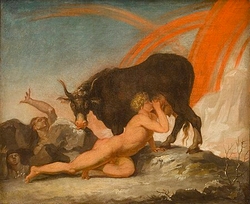
Heat from Muspelheim eventually came to melt the hoar on the opposite side of the canyon, causing it to melt into drops, which eventually formed the first living entity: the gigantic Ymir (Aurgelmir), followed shortly afterwards by the cow Auðumla, whose milk sustained Ymir. Auðumla herself gained sustenance by licking the blocks of salty ice on the Niflheim side of Ginnungagap, which released Búri. Búri later had a son, Borr, who fathered the triad of gods Oðinn, Vili and Vé.
Meanwhile, Ymir gave rise to the first man and woman from his armpits, and the first of the jǫtnar ("giants") from his legs: the eldest of the latter was Þrúðgelmir, whose son Bergelmir, along with his wife, ensured the survival of his race by fashioning an ark which outlasted the deluge caused by the destruction of his grandfather.
This was accomplished by Oðinn, Vili and Vé, who created the cosmos from his remains: -
- Ymir's body became the earth, fashioned in the midst of Ginnungagap;
- his blood became the seas and lakes;
- his flesh the soil;
- his intact bones the rocks;
- his teeth, jaws and broken bones made the stones and pebbles;
- the blood emitted from his wounds became the ocean, which was placed as a ring around the earth, ostensibly impossible to navigate across;
- Ymir's skull was formed into the sky, held up at the cardinal points by four dwarfs.
Taking the sparks from Muspelheim, Borr's sons created the luminaries above and below, the give light to heaven and earth, before creating "resting places [for] all fires," shaping the courses for lava.
Eventually, the cosmos came to be understood as nine worlds, commonly associated with the following: -
- Asgard, home of the Æsir-gods led by Oðinn;
- Álfheimr or Ljósálfheimr, the home of the Ljósálfar ("light elves");
- Vanaheimr, home of the Vanir-gods;
- Midgard, home of humanity;
- Jötunheimr (perhaps identical to the realm of Útgarðr), where lived the jǫtnar;
- Niðavellir (or Svartálfaheimr), where dwelt the dwarfs (possibly identified with the Dökkálfar and/or Svartálfar, the "dark"/"black elves");
- the primordial realm of Niflheim;
- the primordial realm of Muspelheim; and
- Hel or Helheimr, the home of the dishonoured dead, presided over by the goddess Hel.
These worlds were envisaged as being grounded upon the World Tree, Yggdrasil, which had roots in the three wells Hvergelmir, Mimirbrunna and the well of Urðr and her sisters Verðandi and Skulðr. These three, collectively known as the Nornir, were the spinners of the fates of all living things.
ROMANIAN
In the beginning, God created the heavens and the earth. The earth was made after God measured the void beneath heaven using a ball of thread. A mole asked to help, and was given the thread to hold while God carried out His work.
Eventually, due to the mole's negligence in letting out too much thread, the earth was too large for the designated space beneath heaven. This led the mole to hide beneath the earth.
God dispatched a bee to look for the mole, as he wanted the mole's advice on how to rectify the situation. The mole was found and proved to be amused at the prospect of giving God advice.
The bee, however, overheard the mole mumbling that he would squeeze the earth and create the topographical features - valleys and hills.
Otherwise, the primordial cosmos consisted of water, in which only God and Satan were present. God dispatched the latter into the depths to bring up soil to form the earth with. Satan, however, failed as he wished to fashion the earth himself.
Eventually, he dived down without pondering his own plans and managed to bring up some grains of soil. God made a ball and fell asleep.
At this point, Satan tried to carry out his ambitions, but, whenever he touched the earth, it grew, displacing more and more waters.
Once he woke, God saw that there was now no room for the waters, so he approached a hedgehog for advice. The hedgehog refused, on the basis that God ought to be omniscient. In this account, it was the hedgehog's murmurs that were overheard and resulted in God creating mountains and dales.
SAMI
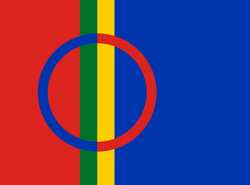
The Sami people tell of ancient days, in which the only things in existence were the Sun and the Earth, the father and mother of the world. They created everything but humanity, who were subsequently created by their son, appropriately titled the Son of the Sun.
However, these early humans had one flaw: they were all male. In order to rectify this situation, the Son of the Sun gathered a crew of his closest, boldest creations and set out by ship to a land of giants to the west of the Sun. This land was ruled by a blind giant king, who had a beautiful daughter. The Son of the Sun was challenged by the king to a finger pulling contest, which he won, making love to the king's daughter as his spoil, and taking her away from her home in his vessel.
However, the giants are not pleased: the girl's brothers are in hot pursuit and the lovers are only able to save themselves through the girl's magic handkerchief and the heat of the solar rays emitted by the Son of the Sun.
Once married, the pair give birth to the ancestors of the Sami, who eventually ascend skyward, becoming the stars.
SIBERIAN

Among the peoples of Siberia are some who name Otsirvani or Otshirvani as the creator.
At the beginning of time, Otsirvani descended from above with his assistant, Chagan-Shukuty. They noticed a frog diving into the primordial ocean.
Chagan-Shukuty reached down and caught it, turning it over to enable Otsirvani to take his place on its stomach.
Next, Chagan-Shukuty was dispatched into the depths, from whence he brought back some earth, which he sprinkled on the belly of the frog.
The frog was now weighted down, and sank into the waters, leaving only the soil visible.
While the two gods slept, the devil came by and attempted to destroy both them and their new creation by picking them up and throwing them into the deep. However, the further he ran, the further the earth extended, until, exhausted, he dropped Otsirvani and Chagan-Shukuty.
The Tatars, meanwhile, explain that the high god calls upon Pajana the creator to come to heaven and give him life magic. Pajana leaves creation in the care of a dog, which, at this stage, had no fur.
Sadly, Erlik spat on the objects created by Pajana, which causes them to require drastic action to make them suitable for life.
SLAVONIC
ROD - THE FIRST CAUSE
Rod - perhaps originally named Deivos - is the supreme god of the cosmos according to Rodnovery, the neo-pagan religion based upon reconstructed Slavonic paganism. The concept of a supreme deity is ancient, however, with the Saxon chronicler Helmold of Bosau, writing in the 12th century, stating that the Slavs held that there was a single deity who produced a host of lesser spirits associated with the natural world. Rod may well have been adopted among the pagan Saxons, who supposedly did obeisance to a certain Krodo.
Rodnovery belief understands the Rod concept as an all-pervading life force, the fount of existence, and origin of the pantheon. Rod exists within a primordial chaos, and produces the circular pattern of Svarog ("heaven"), from which are generated world-eggs. Rod is also the origin of duality in the form of Belobog and Chernobog, the "white" and "black god." Rod created the original world-egg, from which emerged Svarog, who proceeded to fashion the cosmos. This hatching led to the production of the light of Svarog, with Chernobog having his origin in the shadow cast by this light. The egg itself eventually morphed into the world tree.
VYRAJ
A particular domain which may originally have been associated with Rod is that known as Vyraj, Wyraj or Irij, which is described as a paradisiacal, faraway region to which "birds fly for the winter and souls go after death," and from which the spring comes every year. This domain was imagined as existing in the canopy of the World Tree, and was bound by an iron gate preventing ingress. The chthonic deity Veles, in the form of a raróg (a fiery bird of prey), appears in folklore as the guardian of this gateway.
PERUN AND VELES
PERUN
Perhaps the best-known aspect of Slavonic paganism is the dichotomy between the heavens and the chthonic aspects of the earth, personified by the duality Perun-Veles.
Perun is a sky god associated with thunder, lightning, law, war and oak trees, and he is perhaps the first-attested Slavic deity: Procopius, writing during the 6th century, notes that the early South Slavs "acknowledge that one god, creator of lightning, is the only lord of all: to him do they sacrifice an ox and all sacrificial animals." Perun may also be associated with Rod, given Helmold's statement decription of Slavonic paganism considered above. Perun's association with the oak may also signify a correspondence between this deity and the World Tree: Perun is represented as an eagle perched atop this axis mundi, ever watchful over creation. The name of the deity is commonly attested in the names of mountains in Slavic territory too.
Perun's name comes ultimately from proto-Indo-European, where the name *Perkwunos is reconstructed as denoting the god of thunder and lightning. It is closely associated with the Baltic deity known variously as Perkūnas (Lithuanian) or Pērkons (Latvian). This god is second only to the paramount deity Dievas/Dievs/Dīvs (cf. Deivos as a precursor to Rod above).
VELES
In contrast - if not opposition - to Perun stands another god, known variously as Veles, Weles, Vialies or Volos. The domain of Veles is the underworld, the earth and waters. He is said to be dark, wet and bearded, and Veles is closely associated with cattle, the productivity of the earth and magic. He may be represented in East Slavic folktales which depict a dragon dwelling in a tree trunk in order to evade the wrath of his celestial foe.
Interestingly, Veles may have assumed a sheen of Christianisation: St. Blaise, also known as Vlasios, is the patron saint of those who comb wool, an element closely associated with his pagan counterpart. Notwithstanding this circumstance, the Balts also know of a similar figure, known in Lithuanian as Vėlinas and in Latvian as Velns, where he appears as a devil and the archenemy of the Baltic counterpart of Perun.
TRIGLAV AND THE TRIPARTITE COSMOS
The Slavonic cosmogony, in common with many others, seems to have posited three worlds, named in the probable forgery known as the Book of Veles as: -
- Prav - the primordial realm associated with the gods: the name means "Right";
- Iav or Jav - the earth, derived from "actuality"; and
- Nav - the underground world, perhaps identical with the chthonic Vyraj: the name is perhaps derived from a term for a corpse, or else signifies "probability."
This tripartite division is already implicit in the triple character of the deity Triglav: the chronicler Ebbo, writing during the 9th century, describes him as the caretaker of the heavens, earth and underworld.
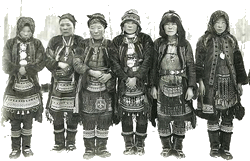
TUNGUSIC
The Tungusic peoples dwell in the extreme east of Siberia and into Manchuria. Their creation narrative is as follows: -
- in the beginning, there was only primordial water;
- God sent down fire, which burnt part of the ocean, causing land to appear;
- descending to the land, God found the devil Buninka there: requesting leave to create his own world and being denied, Buninka, in a fit of pique, broke God's lyre;
- God now decided to test Buninka, challenging him to create a tree from the waters;
- Buninka created a pine tree, but it was weak and immediately leaned over;
- God then created a tree of his own, which was strong and grew continually;
- Buninka now recognised God's supremacy over all of creation.
TURKIC
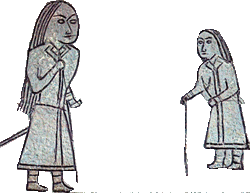
The ancient pre-Islamic religion of the Turkic people was a shamanically-based faith system whose chief deity was the god of the blue sky, Tengri. Tengri, in the form of a goose (Tengri Ülgen) flew over the primeval waters, known as Time, before starting the work of creation at the instigation of the White Mother. His first creation was Er Kishi, who was intended as a helpmeet but proceeded to undermine the work of creation. As a result, Tengri returned to the heavens, from whence he dispatched sacred animal totems to assist the people he had created.
The heavenly host can be contacted through the agency of shamans, who bring back the knowledge they have had bestowed upon them to aid their people below.
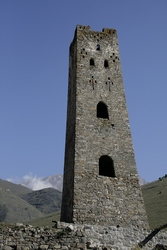
VAINAKH (CHECHEN, INGUSH)
The cosmos is the creation of the supreme being Dela, who fashioned the earth over a period of three years, after which it was thrice the size of the heavens and was set in place atop huge bullhorns. Below this is the subterranean world, Deeli-Malkhi, created in seven years and ruled by Ishar-Deela. The sun goes to Deeli-Malkhi upon setting and rises from this realm.
YUPIK
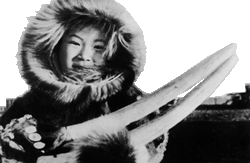
The Yupik of St. Lawrence Island - the Kukulik - are related to both the people of Siberia - whose language they share - as well as the various Yupik and Inuit groups of the north of North America.
When he was in the process of creating the world, Raven made the shore about Cape Chaplin, then the remainder of the Russian part of the world, before turning his attention to creating the Americas. Having rested, he then proceeded to dive into the ocean for sand, out of which he squeezed the water and made a village called Cibukak.
From the pebbles in the sand, he made people, teaching them how to hunt and forage.
Eventually, a man travelled to the Sun to ask for reindeer, but was rebuffed. The Sun did give him some pebbles, however, which, when thrown into the waters, became whales.
